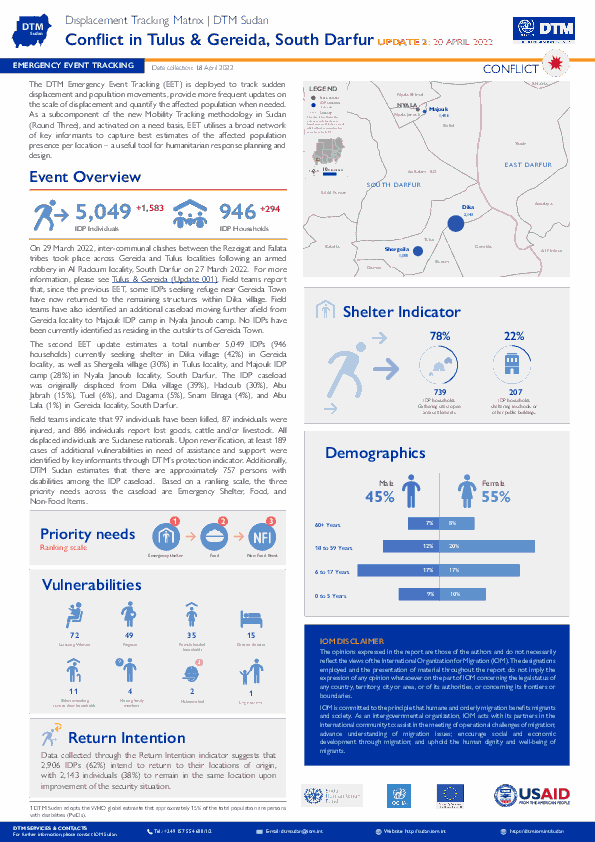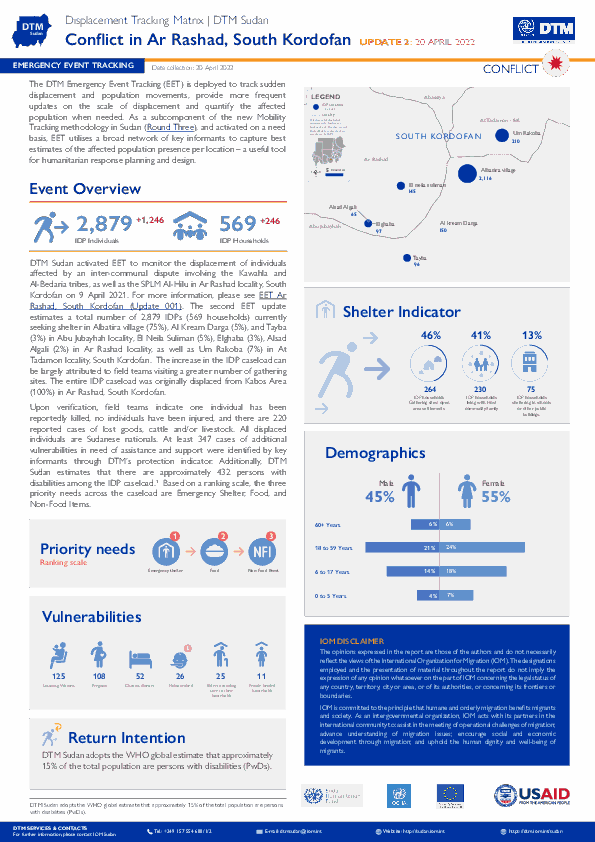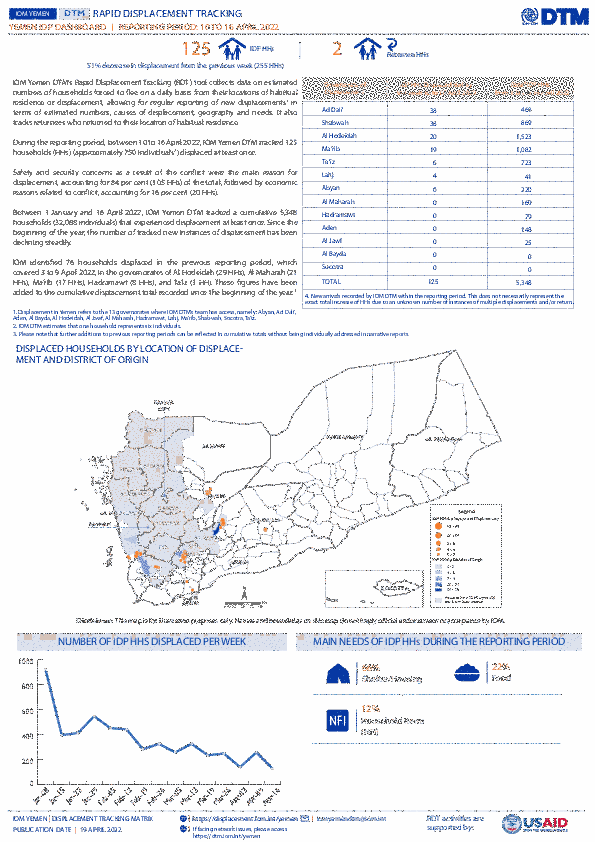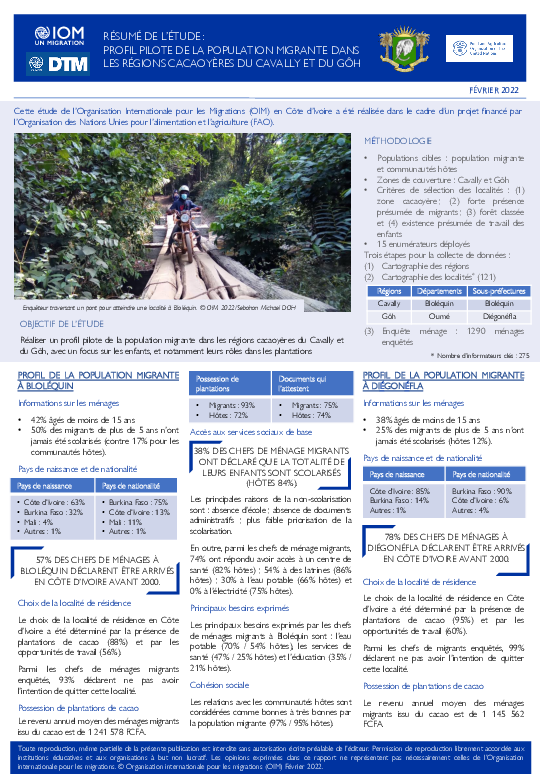-
Countries
-
Data and Analysis
-
Special Focus
-
Crisis Responses

Contact
DTM Sudan; dtmsudan@iom.int
Language
English
Location
Sudan
Snapshot Date
Apr 18 2022
Activity
- Event Tracking
- Mobility Tracking
The DTM Emergency Event Tracking (EET) is deployed to track sudden displacement and population movements, provide more frequent updates on the scale of displacement, and quantify the affected population when needed. As a subcomponent of the new Mobility Tracking methodology in Sudan (Round Three), and activated on a need basis, EET utilises a broad network of key informants to capture best estimates of the affected population presence per location – a useful tool for humanitarian response planning and design.
The instability in the Liptako Gourma region of the Central Sahel has triggered significant displacement in communities in the three bordering countries: Burkina Faso, Mali, and Niger. This complex crisis is fueled by multiple interrelated risk factors, including growing competition over scarce resources, climate change, poverty, lack of livelihood opportunities, communal tensions, demographic pressures, and violence related to organized crime and Non-State Armed Groups. It has led to the death of an estimated 5,000 people in 2021 and has triggered the displacement of more than 2 million individuals throughout the affected countries. However, even as humanitarian and development needs continue to escalate, there is evidence that some displaced persons are returning to their areas of origin or habitual residence, while others face prolonged displacement, including individuals displaced in Northern Mali that left their areas of origin more than a decade ago in 2012.
In order to find durable solutions for internal displacement — whether through return to communities of origin, local integration, or relocation — and to prevent new displacements in the region, it is critical to understand the relative levels of stability in locations hosting returnees or displaced populations. Therefore, IOM has launched the Stability Index (SI) to evaluate and seek to understand which factors influence a location's stability, which can inform priority programmatic interventions along the humanitarian, peace and development nexus in order to strengthen the resilience and stability and prevent future forced displacements. This report presents the results of Stability Index assessments in Niger and Mali.

Contact
DTM Sudan; dtmsudan@iom.int
Language
English
Location
Sudan
Snapshot Date
Apr 20 2022
Activity
- Event Tracking
- Mobility Tracking
The DTM Emergency Event Tracking (EET) is deployed to track sudden displacement and population movements, provide more frequent updates on the scale of displacement, and quantify the affected population when needed. As a subcomponent of the new Mobility Tracking methodology in Sudan (Round Three), and activated on a need basis, EET utilises a broad network of key informants to capture best estimates of the affected population presence per location – a useful tool for humanitarian response planning and design.

Contact
DTM Nigeria, AllUsersInDTMNigeria@iom.int
Language
English
Location
Nigeria
Period Covered
Apr 11 2022
Apr 17 2022
Activity
- Event Tracking
- Mobility Tracking
Nigeria's north-central and north-west zones are afflicted with a multidimensional crisis rooted in long-standing tensions between ethnic and religious groups and involves attacks by criminal groups and banditry/hirabah (such as kidnapping and grand larceny along major highways). During the past years, the crisis has accelerated because of the intensification of attacks and has resulted in widespread displacement across the region.
Between the 11th and 17th of April 2022, armed clashes and banditry have led to new waves of population displacement. Following these events, rapid assessments were conducted by DTM (Displacement Tracking Matrix) field staff to inform the humanitarian community and government partners, and enable targeted response. Flash reports utilise direct observation and a broad network of key informants to gather representative data and collect information on the number, profile and immediate needs of affected populations.
During the assessment period, the DTM identified an estimated 5,338 individuals who were affected by the attacks. A total of 5,187 individuals were displaced to neighbouring wards in the LGAs Guma, Logo and Tarka in Benue State, Kanam in Plateau State and Dange-Shuni and Wurno in Sokoto State. A total of 409 casualties were reported, including 258 injuries and 151 fatalities.

Contact
DTM Nigeria, AllUsersInDTMNigeria@iom.int
Language
English
Location
Nigeria
Period Covered
Apr 09 2022
Apr 15 2022
Activity
- Mobility Tracking
- Baseline Assessment
- Points of Entry (PoE)
During the COVID-19 pandemic, IOM's Displacement Tracking Matrix (DTM), in collaboration with the World Health Organization (WHO), monitors cross-border movements to and from Nigeria's Borno State in north-east Nigeria. Assessments are conducted at Points of Entry located along the border with Cameroon.
A range of data was collected during the assessments to better inform on travellers’ nationalities, sex, reasons for moving, mode of transportation and timeline of movement as shown in figures 2 to 5 below.

Contact
DTM Sudan, DTMSudan@iom.int
Language
English
Location
Sudan
Period Covered
Jan 01 2021
Dec 31 2021
Activity
- Registration
- Rapid Emergency Registration
- Verification for Registration
From January to December 2021, IOM’s Displacement Tracking Matrix (DTM) registered a total of 48,870 persons (8,178 households) – 100% of which were of internally displaced persons (IDPs) with no new registration exercises of returnees since December 2020. DTM Sudan completed a total of ten registration exercises across Central Darfur, South Darfur, and South Kordofan.
Through its flow-monitoring registry (FMR) component, DTM Sudan registered a total number of 4,987 individuals (1,410 households) having entered Sudan via Abyei during 2021, up until 23 December 2021.
Finally, DTM Sudan recorded a total of 3,422 Sudanese nationals returning from the Kingdom of Saudi Arabia (KSA) during 2021. For more information on DTM Sudan’s previous registration activities, please see DTM Sudan Registration Factsheet 2020.

Contact
DTM Europe, DTMMediterranean@iom.int
Language
English
Location
Republic of Moldova
Period Covered
Mar 09 2022
Apr 08 2022
Activity
- Survey
- Flow Monitoring
Since 24 February 2022, increasing numbers of refugees and third-country nationals entering the Republic of Moldova have been registered amid the war in Ukraine. As of 08 April, Moldovan authorities have reported 406,662 arrivals from Ukraine, of whom 370,805 are Ukrainian refugees and 35,857 third-country nationals (TCNs) (Source: General Inspectorate for Border Police, Republic of Moldova).
This report is based on 169 surveys done by IOM and UN Women with third-country nationals (non-Ukrainian and non-Moldovan citizens) between 09 March and 8 April 2022.

Contact
DTM Yemen, iomyemendtm@iom.int
Language
English
Location
Yemen
Period Covered
Apr 10 2022
Apr 16 2022
Activity
- Mobility Tracking
IOM Yemen DTM’s Rapid Displacement Tracking (RDT) tool collects data on estimated numbers of households forced to flee on a daily basis from their locations of origin or displacement, allowing for regular reporting of new displacements in terms of estimated numbers, geography, and needs. It also tracks returnees who returned to their location of origin.
From 1 January to 16 April 2022, IOM Yemen DTM tracked 5,348 households (HH) (32,088 Individuals) who experienced displacement at least once.
Between 10 and 16 April 2022, IOM Yemen DTM tracked 125 households (750 individuals) displaced at least once. The majority of people moved into/within the following governorates and districts:
- Ad Dali (38 HHs) – Qatabah (26 HHs), Ad Dali (12 HHs) districts. Most displacements in the governorate originated from Ad Dali and Ibb.
- Shabwah (38 HHs) – Bayhan (32 HHs), Ataq (6 HHs) districts. Most displacements in the governorate originated from Al Bayda.
- Al Hodeidah (20 HHs) – Hays (18 HHs), Al Khukhah (2 HHs) districts. Most displacements in the governorate originated from Al Hodeidah and Taiz.
The majority of people moved from the following governorates and districts:
- Al Bayda (35 HHs) – Nati (28 HHs), Numan (4 HHs), Az Zahir - Al Bayda (2 HHs) districts.
- Al Hodeidah (30 HHs) – Hays (11 HHs), Zabid (6 HHs), At Tuhayta (4 HHs) districts.
- Ad Dali (19 HHs) – Qatabah (12 HHs), Al Husha (3 HHs), Damt (3 HHs) districts.

Contact
ANanquette@iom.int
Language
French
Location
Côte d’Ivoire
Period Covered
Feb 01 2022
Feb 28 2022
Activity
- Flow Monitoring
Cette étude de l’Organisation Internationale pour les Migrations (OIM) en Côte d’Ivoire a été réalisée dans le cadre d’un projet financé par l’Organisation des Nations Unies pour l’alimentation et l’agriculture (FAO), afin de réaliser un profil pilote de la population migrante dans les régions cacaoyères du Cavally et du Gôh, avec un focus sur les enfants, et notamment leurs rôles dans les plantations.
Contact
DTM Yemen, iomyemendtm@iom.int
Location
Yemen
Activity
- Event Tracking
- Mobility Tracking
Period Covered
Apr 10 2022 -Apr 16 2022
IOM Yemen DTM’s Rapid Displacement Tracking (RDT) tool collects data on estimated numbers of households forced to flee on a daily basis from their locations of origin or displacement, allowing for regular reporting of new displacements in terms of estimated numbers, geography, and needs. It also tracks returnees who returned to their location of origin.
From 1 January to 16 April 2022, IOM Yemen DTM tracked 5,348 households (HH) (32,088 Individuals) who experienced displacement at least once.
Between 10 and 16 April 2022, IOM Yemen DTM tracked 125 households (750 individuals) displaced at least once. The majority of people moved into/within the following governorates and districts:
From 1 January to 16 April 2022, IOM Yemen DTM tracked 5,348 households (HH) (32,088 Individuals) who experienced displacement at least once.
Between 10 and 16 April 2022, IOM Yemen DTM tracked 125 households (750 individuals) displaced at least once. The majority of people moved into/within the following governorates and districts:
- Ad Dali (38 HHs) – Qatabah (26 HHs), Ad Dali (12 HHs) districts. Most displacements in the governorate originated from Ad Dali and Ibb.
- Shabwah (38 HHs) – Bayhan (32 HHs), Ataq (6 HHs) districts. Most displacements in the governorate originated from Al Bayda.
- Al Hodeidah (20 HHs) – Hays (18 HHs), Al Khukhah (2 HHs) districts. Most displacements in the governorate originated from Al Hodeidah and Taiz.
- Al Bayda (35 HHs) – Nati (28 HHs), Numan (4 HHs), Az Zahir - Al Bayda (2 HHs) districts.
- Al Hodeidah (30 HHs) – Hays (11 HHs), Zabid (6 HHs), At Tuhayta (4 HHs) districts.
- Ad Dali (19 HHs) – Qatabah (12 HHs), Al Husha (3 HHs), Damt (3 HHs) districts.
The majority of people moved from the following governorates and districts:
Population Groups
Survey Methodology
Unit of Analysis Or Observation
Type of Survey or Assessment
Keywords
Geographical Scope
Administrative boundaries with available data
The current dataset covers the following administrative boundaries

